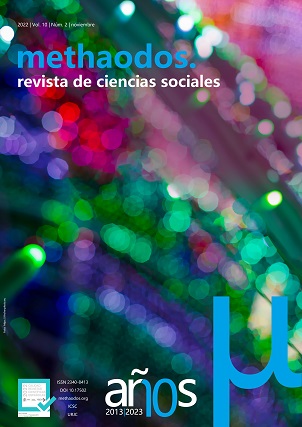The perception of insecurity in Spanish society facing exceptional situations: COVID-19 and war in Ukraine
Main Article Content
Abstract
The present work analyze the Spanish society's feeling of insecurity in the face of two such unequal phenomena as a global pandemic and a war in a neighbouring country of the European Union, localised but with the capacity to unleash a conflict with destructive consequences as yet unproven by humanity. We show that the feeling of insecurity in the face of exceptional situations can be differentiated from that which the population experiences fronting delinquency and criminality, on which we establish a theoretical basis. We also address the relationship between insecurity and fear, which are sometimes considered interchangeably. Using the statistical method and CIS survey data, we identify the population variables related to their feelings of insecurity, with age being important in both cases, together with other circumstantial factors. Likewise, we have identified a relevant relationship between insecurity in the face of COVID-19 and the claim for more demanding control and isolation measures, as well as between insecurity in the face of the war in Ukraine and the desire for greater investment in defence and the creation of a European army. The results obtained help us to establish lines of work for future social research on public insecurity.
Downloads
Article Details

This work is licensed under a Creative Commons Attribution-NonCommercial 4.0 International License.
References
Antón, F. (2015). Antropología del miedo. methaodos.revista de ciencias sociales, 3(2), 262-275. http://dx.doi.org/10.17502/m.rcs.v3i2.90
Antón-Mellón, J., Álvarez, G. y Rothstein, P. (2017). Populismo punitivo en España (1995-2015): presión mediática y reformas legislativas. Revista Española De Ciencia Política, (43), 13-36. https://doi.org/10.21308/recp.43.01
Bar-Tal, D. (2001). Why does fear override hope in societies engulfed by intractable conflict, as it does in the Israeli society? Political Psychology, 22, 601-627. https://doi.org/10.1111/0162-895X.00255
Bauman, Z. (2006). Liquid fear. Polity Press.
Beck, U. (1992). Risk Society: Towards a New Modernity. Sage.
Barrett, C.B. (2010). Measuring Food Insecurity. Science, 327 (5967), 825-828.
Brubaker, R. (2020). Digital hyperconnectivity and the self. Theory and Society, 49, 771-801.
Caro, M.J y Navarro, L. (2017). La medición del miedo al delito a través de los barómetros del CIS. Revista Española de Investigaciones Sociológicas, 157, 23-44.
Caro, M.J., Pozo, F., López, A. y Navarro, L. (2020). Encuestas de seguridad ciudadana. Centro de Investigaciones Sociológicas.
Ceccato, V. (Ed.). (2012). The Urban Fabric of Crime and Fear. Springer.
Cossman, J.S. y Rader, N.E. (2011). Fear of crime and personal vulnerability: examining self-reported health. Sociological Spectrum, 31(2), 141-162. https://doi.org/10.1080/02732173.2011.541339
Crespo, I., Medina, R.M., Garrido, A., Belinchón, M., y Parodi, J. (2017). ¿Estamos preparados? La gestión de comunicación de crisis en la administración pública española. Instituto Nacional de Administración Pública.
Cvetković, V.M., Öcal, A. y Ivanov, A. (2019). Young adults' fear of disasters: A case study of residents from Turkey, Serbia and Macedonia. International Journal of Disaster Risk Reduction, 35. https://doi.org/10.1016/j.ijdrr.2019.101095
Díez, J. (1986). La transición Política y la opinión pública española ante los problemas de la defensa y hacia las Fuerzas Armadas. Reis: Revista Española de Investigaciones Sociológicas, 36, 13-24. https://www.jstor.org/stable/40183243
Ditton, J. y Farrall, S. (Eds.). (2000). The fear of crime. Routledge.
EU FRA (2021). Crime, safety and victims' rights. Fundamental Rights Survey. Publications Office of the European Union. https://doi.org/10.2811/351635
Farré, J. (2005). Comunicación de riesgo y espirales del miedo. Comunicación y Sociedad, 3, 95-119.
Foley, E., Ross, L., y Arista, C. (2013). Basketball Courts, Street Corners and Empty Lots: The Spatial Dimensions of Youth Fear and Vulnerability to Violence. Children, Youth and Environments, 23(1), 43-63. https://www.jstor.org/stable/10.7721/chilyoutenvi.23.1.0043
Giddens, A. (1990). Consequences of Modernity. Polity Press.
Gregory, R. (1989). Political Rationality or ‘Incrementalism’? Charles E. Lindblom’s enduring contribution to public policy making theory. Policy and Politcs, 17 (2), 139-153. https://doi.org/10.1332/030557389782454893
Koonings, K. and Kruijt, D. (Eds.). (1999). Societies of fear: the legacy of civil war, violence and terror in Latin America. Zed Books.
Jervis, R. (1976). Perception and misperception in international politics. Princeton University Press.
Lauritsen, J.L. y Heimer, K. (2010). Violent victimization among males and economic conditions. The vulnerability of race and ethnic minorities. Criminology & Public Policy, 9(4): 665-692. https://doi.org/10.1111/j.1745-9133.2010.00660.x
Long, J.S. (1997). Regression Models for Categorical and Limited Dependent Variables. Sage.
Long, J.S. y Freese, J. (2006). Regression Models for Categorical Dependent Variables Using Stata. Stata Press.
Mauss, M. (2002). The gift: The form and reason for exchange in archaic societies. Routledge.
Maslow, A. (1970). Motivation and Personality (2nd ed.). Harper and Row.
Millstein, S.G. y Halpern-Felsher, B.L. (2002). Perceptions of risk and vulnerability. Journal of Adolescent Health, 31 1), Sup. 1, 1’-27. https://doi.org/10.1016/s1054-139x(02)00412-3
Morillas, D.L., Patró, R.M. y Aguilar, M.M. (2014). Victimología: un estudio sobre la víctima y los procesos de victimización (2ª ed.). Dykinson.
Navarrete, A. (1963). Desarrollo y Seguridad Económica. Investigación Económica, 23(90), 479-490. http://www.jstor.org/stable/42778113
Papadopoulos, R.K. (2006). Terrorism and panic. Psychotherapy and Politics International, 4(2), 90-100. https://doi.org/10.1002/ppi.105
Rahn, W.M., Kroeger, B. y Kite, C.M. (1996). A Framework for the Study of Public Mood. International Society of Political Psychology, 17(1), 29-58.
Ropeik, D. (2004). The consequences of fear. EMBO reports, 5(S1), 56-60. https://doi.org/10.1038/sj.embor.7400228
Slovic, P. (Ed.) (2000). The perception of risk. Routledge.
Snedker, K.A. (2012). Explaining the Gender Gap in Fear of Crime: Assessments of Risk and Vulnerability Among New York City Residents. Feminist Criminology, 7(2), 75-111. https://doi.org/10.1177/1557085111424405
Stimson, J.A. (1991). Public opinion in America: Moods, cycles and swings. Westview.
Urteaga, E. y Eizagirre, A. (2013). La construcción social del riesgo. Empiria. Revista de Metodología de Ciencias Sociales, 25, 147-170.
Visser, M., Scholte, M. y Scheepers, P. (2013). Fear of Crime and Feelings of Unsafety in European Countries: Macro and Micro Explanations in Cross-National Perspective. The Sociological Quarterly, 54, 278-301. https://doi.org/10.1111/tsq.12020
Watson, J.T., Gayer, M., y Connolly, M.A. (2007). Epidemics after natural disasters. Emerging infectious diseases, 13 (1), 1-5. https://doi.org/10.3201/eid1301.060779
Yñiguez, A. (2007). Reglas básicas de la práctica policial y funcionamiento interno de la Policía. Cuadernos de Trabajo Social, 20, 57-73.

